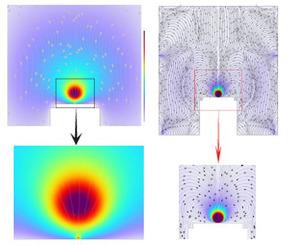Local concentration focusing effect on deposition efficiency caused by inlet of fluids in MPCVD reactor
IF 5.1
3区 材料科学
Q2 MATERIALS SCIENCE, COATINGS & FILMS
引用次数: 0
Abstract
Microwave Plasma Chemical Vapor Deposition (MPCVD) has emerged as a prominent technique for advanced material synthesis, particularly diamond growth, characterized by inherently complex multiphysical phenomena. At moderate gas pressures (on the magnitude of 0.1 atmospheric pressure), flow effects play a substantial role in MPCVD reactors. However, most previous studies choose to neglect these flow characteristics due to huge computational challenges in multiphysical modeling. Empirical evidence has demonstrated that strategic modifications to fluid inlet configurations may enhance diamond deposition rates by an order of magnitude, yet the underlying mechanisms remain inadequately understood. This study implements a comprehensive multiphysical modeling framework incorporating coupled electromagnetic field, plasma field, flow field, and temperature field. Special attention is given to plasma characterization as a multi-component system requiring rigorous treatment through Maxwell–Stefan diffusion theory. However, previous theoretical analysis reveals a critical limitation in conventional Maxwell–Stefan implementations, which is the inherent assumption of inviscid flow. This contradicts the viscous nature of MPCVD operational environments, as evidenced by our simulation results, demonstrating the necessity of viscous diffusion integration in heavy species transport to achieve experimental consistency. The inclusion of viscous diffusion mechanisms reveals enhanced hydrogen atom concentration near substrate apertures through inlet-induced flow modifications. This concentration enhancement directly correlates with improved deposition rates as per the Goodwin–Harris model. Our findings establish that viscous diffusion constitutes a previously overlooked yet critical transport mechanism in MPCVD reactors, complementing conventional mass diffusion and convective transport. This revelation provides new fundamental insights into diamond deposition mechanisms and proposes a novel process optimization paradigm through transport manipulation.

MPCVD反应器入口流体对沉积效率的局部浓度聚焦效应
微波等离子体化学气相沉积(MPCVD)已成为先进材料合成的重要技术,特别是金刚石生长,其特点是固有的复杂的多物理现象。在中等气体压力下(0.1大气压量级),流动效应在MPCVD反应器中起重要作用。然而,由于在多物理场建模中存在巨大的计算挑战,以往的研究大多选择忽略这些流动特性。经验证据表明,对流体入口配置进行战略性调整可能会提高金刚石沉积速率一个数量级,但其潜在机制仍未得到充分了解。本研究实现了综合电磁场、等离子体场、流场和温度场的多物理场建模框架。特别注意的是,等离子体表征作为一个多组分系统,需要通过麦克斯韦-斯特凡扩散理论进行严格的处理。然而,先前的理论分析揭示了传统麦克斯韦-斯蒂芬实现的一个关键限制,即固有的无粘流假设。这与MPCVD操作环境的粘性性质相矛盾,正如我们的模拟结果所证明的那样,证明了在重物质输运中粘性扩散积分的必要性,以实现实验一致性。黏性扩散机制的包含揭示了通过入口诱导的流动修饰在衬底孔附近增加氢原子浓度。根据古德温-哈里斯模型,这种浓度的增强与沉积速率的提高直接相关。我们的研究结果表明,在MPCVD反应器中,粘性扩散是一种以前被忽视的关键输运机制,补充了传统的质量扩散和对流输运。这一发现为金刚石沉积机制提供了新的基本见解,并提出了一种通过传输操纵的新型工艺优化范例。
本文章由计算机程序翻译,如有差异,请以英文原文为准。
求助全文
约1分钟内获得全文
求助全文
来源期刊

Diamond and Related Materials
工程技术-材料科学:综合
CiteScore
6.00
自引率
14.60%
发文量
702
审稿时长
2.1 months
期刊介绍:
DRM is a leading international journal that publishes new fundamental and applied research on all forms of diamond, the integration of diamond with other advanced materials and development of technologies exploiting diamond. The synthesis, characterization and processing of single crystal diamond, polycrystalline films, nanodiamond powders and heterostructures with other advanced materials are encouraged topics for technical and review articles. In addition to diamond, the journal publishes manuscripts on the synthesis, characterization and application of other related materials including diamond-like carbons, carbon nanotubes, graphene, and boron and carbon nitrides. Articles are sought on the chemical functionalization of diamond and related materials as well as their use in electrochemistry, energy storage and conversion, chemical and biological sensing, imaging, thermal management, photonic and quantum applications, electron emission and electronic devices.
The International Conference on Diamond and Carbon Materials has evolved into the largest and most well attended forum in the field of diamond, providing a forum to showcase the latest results in the science and technology of diamond and other carbon materials such as carbon nanotubes, graphene, and diamond-like carbon. Run annually in association with Diamond and Related Materials the conference provides junior and established researchers the opportunity to exchange the latest results ranging from fundamental physical and chemical concepts to applied research focusing on the next generation carbon-based devices.
 求助内容:
求助内容: 应助结果提醒方式:
应助结果提醒方式:


